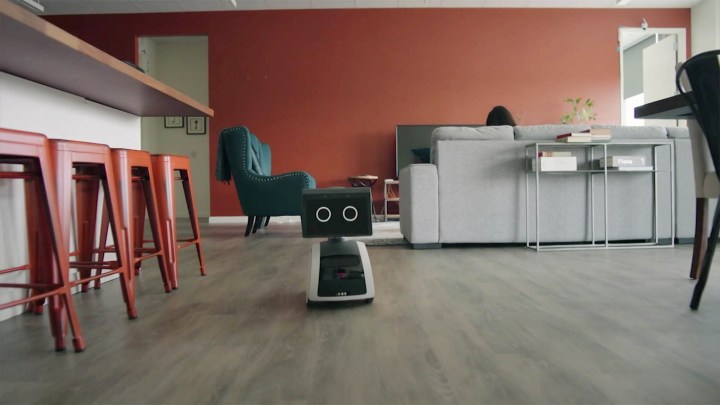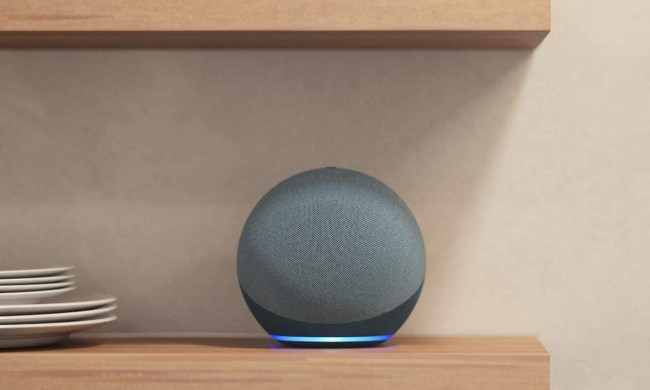Amazon Astro came as a surprise when it was revealed in September 2021. The quirky device does a little bit of everything, serving as a robot companion that boasts facial recognition, impressive navigation skills, and tons of useful home security features.
But a lot has changed with Astro since it was first announced, and it’s gotten some new competition in the form of EBO X. Here’s a look at everything we know about Astro, including how you can get your hands on it and add it to your home.
Designed to rove around the home

Amazon calls Astro a “household robot.” This little device is designed to be an assistant throughout the home, helping with everything from home security to carrying cargo. It has no arms, but does come with a cargo bin. Users can place an item in the bin (or in one of the accessories, like a cup holder — sold separately, of course) and ask Astro to take the item to another member of the home. Thanks to facial recognition features, Astro can be taught to distinguish different family members from one another. If your spouse asks for a beer while watching the football game, just pass one to Astro and let it handle the job.
Along with facial recognition for individual members of your home, it can now detect pets. It can even be set up so that it records your pet while you’re away from home and gives you periodic updates on its well-being. You’ll still need to hire a sitter to take your dog out or feed your cat (poor Astro still doesn’t have any limbs), but it’s a fun feature, nonetheless.
One example Amazon showed off for how useful the robot could be was in assisting elderly family members: checking on them, taking a video call to them, and more. Despite all of these features, the main area where Astro is likely to excel is in its ability to keep an eye on the home. This little robot is equipped with a variety of cameras and sensors.
A new report also indicates that Amazon will be bringing AI smarts to Astro in the future — although details are still a bit murky.
A display that sees and smiles

Its “face” is a screen that can stream video calls, play Prime Video, and much more. It holds some of the same features as the newer Echo Shows in that it can move to keep you centered in the frame, but it takes this feature a step further by following users around the home to keep them centered. Large wheels and advanced navigation features allow it to maneuver around the home with ease, while a powerful braking system lets Astro stop if an obstacle appears in front of it. It utilizes SLAM (simultaneous localization and mapping) technology to maneuver through the home.
Security guard when you’re not home
Astro is primarily designed to be a security measure within the home. Its powerful security features allow it to watch out for potential trouble inside your home, even without your input. Astro can autonomously patrol your home and investigate unusual events. It picks up on these events through motion and sound detection. For example, it utilizes the same features as Alexa Guard. If Astro detects the sound of breaking glass or a beeping fire alarm, it can go investigate.
A periscope camera in the middle of Astro’s “head” can telescope to get a better view of a room and its contents. Amazon showed Astro using this camera to keep an eye on a room as part of its scanning mode. However, this can also be used to investigate specific things — like whether or not you turned off the oven or locked the front door. Any video recordings made through Astro are saved to the cloud through the Ring Protect Pro service.
In a way, a roving security robot can be helpful. It reduces the need for multiple cameras in the home, but many people have raised concerns about the privacy implications of a device like this. According to Amazon, Astro was built with a strong focus on privacy. It has a physical button to turn off the camera, the mics, and its ability to move. When Astro is streaming video, an LED atop the periscope lights up.
Astro has also become useful for small businesses, as it can patrol a warehouse or office space and provide status alerts. It can also use Ring’s Virtual Security Guard feature to better investigate disturbances at locations with other Ring devices installed.
Battery life on par with that of robot vacuums
Astro uses a docking system similar to that of robot vacuums. When not in use, it will dock itself to recharge. Based on technical specifications, Astro can reach a full charge in around 45 minutes to an hour and will be able to run for up to several hours before it needs to be recharged.
The robot’s effective battery life will largely depend on how much you use it, as well as what you use it for. A simple patrol won’t take as much battery power as using Astro to make video calls or stream content.
Can it fall down stairs?
On the same day of Astro’s announcement, there was a leaked report about the efficacy of the robot that claimed it was far more fragile than Amazon had said. It also claimed Astro tumbled down stairs on a regular basis during early development. While this may be true, Amazon contradicts these comments — and our own experience with similar navigation systems throws some skepticism on the claims about Astro’s inability to navigate. Custom cliff sensors on Astro will help it distinguish what’s in its navigational path to prevent it from going over stairs. Astro also can’t climb stairs (due to its lack of legs) and will be limited to serving you on a single floor.
Can it work with Siri and Google Assistant?
No word has been given on whether Astro will work with Siri or
How much does Astro weigh?
Based on Amazon’s provided technical specs, Astro weighs about 20.6 pounds.
What happens if the Wi-Fi turns off?
If Astro can no longer stream to the cloud, you won’t receive alerts or notifications until the connection is restored. It isn’t clear whether Astro will include an SD card port for onboard memory, although the device does have USB-C port.
Pricing and availability
Its retail price is $1,600, but it’s purchasable by invitation only. That means you won’t be able to simply log into your Amazon account and order the companion. There’s been no announcement for when Astro will launch publicly — so stay tuned for more details.





